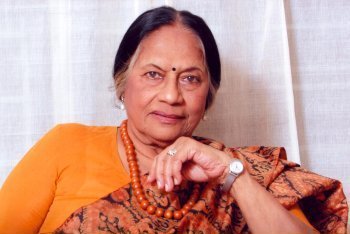
|
 |

|
 |
Kumudini Lakhia - Kiran Rajagopalan, Chennai e-mail: kiran.rajagopalan@gmail.com December 13, 2009  With a lifetime of devotion to Kathak dance, Kumudini Lakhia's imaginative exploration of the Kathak form for choreography has taken Kathak beyond a specific style into a universe of artistic value. No other Indian classical dancer has created the number of compositions based on classical dance as those created by Kumudini Lakhia. She was one of the first amongst the Kathak dancers to visualize this particular dance style in a contemporary context. Some of her well-known choreographic pieces such as 'Dhabkar,' 'Atah Kim' and 'The Coat' are landmarks in the annals of Indian dance. She has participated in numerous dance seminars, given lecture - demonstrations and conducted master classes in many dance centres all over the world. She established Kadamb Centre for Dance and Music in 1967 in Ahmedabad, and has trained many excellent dancers. How difficult was it to initially break away from traditional practice and performance of Kathak and to then develop your own vision of the art? I never did break away from the traditional form of Kathak. Training in a traditional form not only gives you the source, but also the strength to think beyond the accepted format. I always knew that there was much more to Kathak than met the eye. It was because the performer who played to the applause from the audience, which came only from chakkars and foot work, that Kathak vocabulary started to look limited. What is your teaching style like? How should gurus nurture young dancers into becoming discerning choreographers and/or performers in their own right? In the teaching of Kathak, I tried to incorporate much of the Kathak vocabulary which I had learnt from my Gurus. It was also important to make the learning easily understood and to make the learning experience more enjoyable as students today are stressed with their academic performance which has become very competitive. Not all students want to take up dance as a career, but for those who want to, special attention is required. Of all my students, those who have become professional in the dance field have a holistic approach to life and have shown a keen interest not only in dance but in the general progress of their environment. The eminent Gujarati composer Atul Desai has been associated with Kadamb, your institute in Ahmedabad, for five decades! What are the advantages of working with one composer for such a long time? How did his music evolve as he composed for your works over the years? Atul Desai is an extremely sensitive artist. His strength has been in his interest in literature from which he gets a variety of information and which has helped him in maintaining a high standard of values and aesthetics. He started to appreciate dance by watching it closely. He felt the pulse of the dance through which he was able to transform any theme, situation, or mood into a musical experience. Our association has lasted for 50 years because Atul Desai's music brought a special artistic experience to one and all at Kadamb. What is your favorite holiday or festival celebrated in India and why? India has many festivals and holidays. Different states of India have their own way of celebrations. In Gujarat it is kite-flying, in Maharashtra it is Ganapati, in UP it is Holi, in Bengal it is Durga Puja, in the South it is Pongal, and so on. Diwali is the common festival everywhere because a light is the symbol of knowledge. Contact: kadamb@vsnl.net |